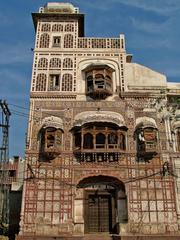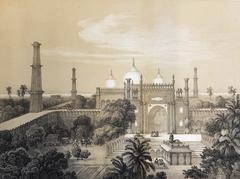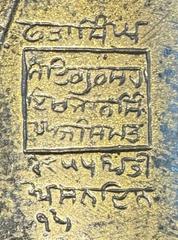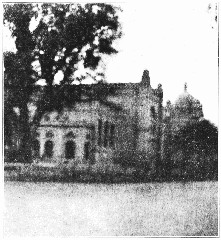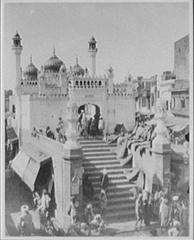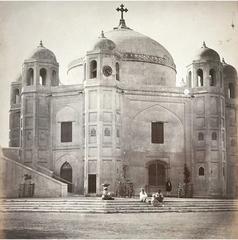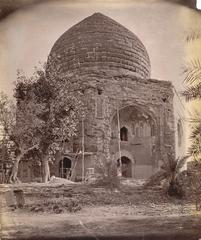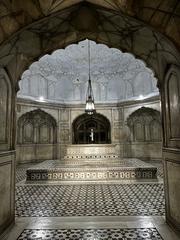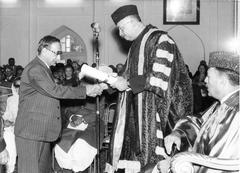Roshnai Gate Visiting Hours, Tickets, and History Guide in Lahore
Date: 15/06/2025
Introduction: The Gate of Lights in Lahore’s Heritage
Roshnai Gate, or “Roshnai Darwaza” (“Gate of Lights”), stands as one of Lahore’s most remarkable historical landmarks. Once the principal southern entrance to the city for Mughal emperors and dignitaries arriving from the river, this gate encapsulates centuries of Lahore’s layered history—from Mughal grandeur to Sikh and British influences. Today, Roshnai Gate greets visitors with its enduring architecture and offers a living window into the city’s vibrant culture and heritage. This guide provides comprehensive information on the gate’s origins, architectural evolution, visiting hours, ticketing, accessibility, and travel tips, as well as highlights its continuing importance in Lahore’s urban narrative (Walled City Lahore Authority; Wikipedia; The Friday Times; Apricot Tours).
Contents
- Introduction and Significance
- Historical Origins and Architectural Features
- Etymology and Symbolism
- Role Across Mughal, Sikh, and Colonial Eras
- Urban Context and Surroundings
- Visiting Hours, Ticketing, and Accessibility
- Travel Tips and Best Seasons
- Preservation and Restoration
- Notable Events and Anecdotes
- FAQs
- Conclusion and Visitor Summary
- Sources and Further Reading
Historical Origins and Architectural Features
Mughal Foundations and Design
Roshnai Gate was constructed during Lahore’s Mughal period, when the city served as a thriving imperial capital. The gate’s original design reflects Mughal priorities: a grand arched entryway oriented south, flanked by robust barrack-like wings, allowing ceremonial processions and royal entourages—including elephants and carriages—to pass with ease. Its structure, largely preserved over the centuries, is a rare example among Lahore’s original thirteen gates (Walled City Lahore Authority).
Architectural Style
Built primarily with red brick and lime mortar, the gate exemplifies Indo-Islamic Mughal architecture. Its facades are comparatively austere, emphasizing monumental scale with pointed arches and minimal ornamentation. Parapets and niches historically accommodated oil lamps, reinforcing the gate’s association with light and its ceremonial function (Graana; Zameen).
Etymology and Symbolism: The “Gate of Lights”
The name “Roshnai” is derived from the Persian word for “light.” In Mughal times, the gate was illuminated with lamps and torches at night, ensuring safe passage for nobles and travelers arriving after dusk. This tradition of lighting not only enhanced security but also symbolized Lahore’s hospitality and grandeur (Dawn; The Friday Times).
Role Across Mughal, Sikh, and Colonial Eras
Mughal and Sikh Periods
Roshnai Gate’s strategic location between Lahore Fort and Badshahi Mosque made it the focal point for state functions, military parades, and imperial processions. During the Sikh era, Hazuri Bagh was added adjacent to the gate, symbolizing Sikh authority and further enriching the area’s historical landscape (Walled City Lahore Authority).
British Colonial Transformation
With the advent of British colonial rule, many of Lahore’s gates were demolished to facilitate urban expansion, but Roshnai Gate was spared and restored, retaining its original orientation and design.
Urban Context and Surroundings
Roshnai Gate sits at the confluence of Lahore’s most important monuments: to its north, the UNESCO-listed Lahore Fort; to its west, the monumental Badshahi Mosque; and adjacent, the lush Hazuri Bagh and Allama Iqbal’s mausoleum. The nearby Shahi Mohalla bazaar and Anarkali Bazaar add to the cultural vibrancy, making the gate a perfect starting point for exploring Lahore’s historic core (Wikipedia; Zameen; Apricot Tours).
Visiting Hours, Ticketing, and Accessibility
Visiting Hours
Roshnai Gate is generally open to visitors daily from 8:00 AM to 7:00 PM. Hours may vary slightly due to public holidays or special events, so it is advisable to confirm before your visit (Trip.com).
Ticket Policy
Entry to Roshnai Gate is free. However, nearby attractions such as Lahore Fort and Badshahi Mosque require separate tickets, which can be purchased at their respective entrances or online.
Accessibility
The area surrounding Roshnai Gate is pedestrian-friendly, with ramps and paved paths for differently-abled visitors. However, some uneven surfaces and steps may pose challenges; guided tours can offer additional support.
Travel Tips and Best Seasons
- Best Season: Visit from October to March for pleasant weather.
- Best Time: Early morning or late afternoon for optimal lighting and fewer crowds.
- Getting There: Easily accessible by public transport, rickshaw, or car; parking available near Food Street and Lahore Fort.
- What to Wear: Comfortable shoes for walking; modest attire respecting local customs.
- Safety: The area is generally safe, but remain vigilant in crowded spaces.
- Local Experience: Enjoy nearby Food Street, try local cuisine, and explore the vibrant bazaars.
Preservation and Restoration
Ongoing preservation by the Walled City of Lahore Authority (WCLA) ensures Roshnai Gate remains the only original gate still largely intact. Restoration efforts address environmental wear and infrastructural needs in collaboration with local communities (Walled City Lahore Authority).
Notable Events and Anecdotes
Roshnai Gate has witnessed countless historic events, from Mughal imperial processions to Sikh ceremonies and British reforms. Among local lore is the tragic 1840 incident where Prince Nau Nihal Singh suffered a fatal accident at the gate—a story that adds a poignant chapter to its legacy (The Friday Times).
Frequently Asked Questions (FAQs)
What are Roshnai Gate’s visiting hours?
Generally, 8:00 AM to 7:00 PM daily.
Is there an entry fee?
No, entry to Roshnai Gate is free.
Are guided tours available?
Yes, local operators and the WCLA offer guided heritage walks and tours (Apricot Tours).
Is the site accessible for people with disabilities?
Ramps and paved paths are provided, but some uneven terrain remains.
What are nearby attractions?
Lahore Fort, Badshahi Mosque, Hazuri Bagh, Anarkali Bazaar, Shahi Mohalla, and Food Street.
Conclusion and Visitor Summary
Roshnai Gate stands as a luminous symbol of Lahore’s continuity—a bridge between the city’s imperial past and its living present. Its enduring architecture, cultural significance, and central location make it a must-visit for history buffs, architecture lovers, and curious travelers alike. Ongoing restoration and cultural programming ensure that the gate remains accessible, vibrant, and relevant for future generations. Plan your visit with confidence, and let Roshnai Gate be your entry point into the heart of Lahore’s history.
For the latest updates, guided tours, and travel resources, download the Audiala app and follow official heritage channels.
Sources and Further Reading
- Walled City Lahore Authority – Roshnai Gate
- Walled City Lahore Authority – Roshnai Gate Heritage
- Wikipedia – Roshnai Gate
- Apricot Tours – Lahore Heritage Tours
- Trip.com – Roshnai Gate Visitor Information
- The Friday Times – The Fort-Mosque Complex
- Graana – The 13 Gates of Lahore
- Zameen – Thirteen Gates of Lahore
- Dawn – Lahore’s Historic Gates
- GPSmyCity – Roshnai Gate
- Medium – Historical 12 Gates of Lahore
- Guide to Pakistan – Lahore Destinations
